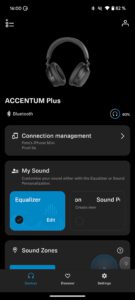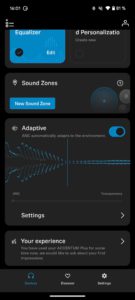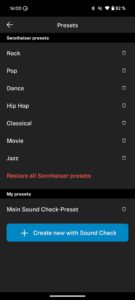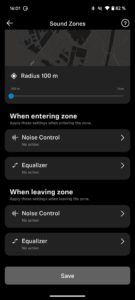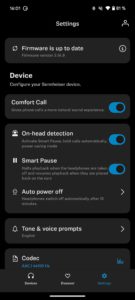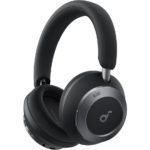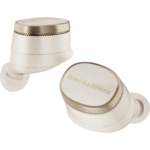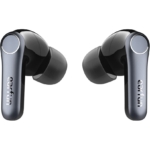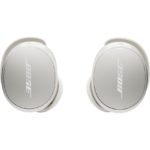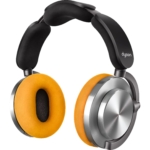50 hours of battery life on a single charge, modern sound tuning and a high level of wearing comfort – the new Sennheiser Accentum Plus Wireless are just as inspiring of confidence as the recently tested Sennheiser Accentum Wireless. The suffix “Plus” means that useful features have been adopted from the larger Momentum 4 Wireless.
- Sound
- Noise cancelling
- Wearing comfort
- Codec variety
- Battery life
- distortion via mini jack in certain situations
For Sonova and Sennheiser alike, there seems to be a considerable difference between the Accentum Wireless and Momentum 4 Wireless. Especially when it comes to operation. And so, the manufacturer claims to have created “the perfect fusion between outstanding sound and convenient features”. In this review, we will take a closer look at whether this turns out to be true.
How does the Accentum Plus differ from the Accentum and Momentum 4 Wireless?
If you’re not sure what the differences are between these three pairs of headphones, we will break it down for you:
The Plus model offers the same technology as the model without Plus, but there were slight differences in terms of Bluetooth codecs: The regular model uses aptX HD, while on the Plus, this has been replaced by aptX Adaptive (see our guide). The battery lasts just as long, with up to 50 hours, but charging takes half an hour longer, now taking 3.5 hours.
The Accentum Plus inherits the adaptive ANC, touch controls, practical auto-pause function and analogue mini jack connection from the larger Momentum models. The Plus also has a carrying case with internal elasticated straps to securely hold the USB and mini jack cable in place, something that the smaller model lacks. The Momentum’s aeroplane adapter is also missing.
Sennheiser Accentum Plus Wireless features and wearing comfort
These over-ears arrive in a travel-friendly pouch, and they fit neatly inside, thanks to their swivelling earcups. The Sennheiser Accentum Plus Wireless headphones have a rail that disappears into the headband for step-less size adjustment. This bears the manufacturer’s logo in silver on the left and right and has a soft padding that is covered in silicone. There is also a notch for pressure relief. The thick, replaceable ear pads are made of soft imitation leather and have a diameter of approx. 4cm x 6cm, and these distribute pressure extremely comfortably on and around the ears. As someone who wears glasses, I had no problems with this: nothing pinched, and the pads still sealed well enough that the acoustic chamber under the ear pads always remained closed.
The same issue that applied to the Accentum also applies to the Plus: For my taste, the contact pressure was a little too high, and I had to take the headphones off my head after about 1.5 hours to relieve the pressure. From experience, however, I found that the headband expands a little if you wear them for longer periods.
Bluetooth
The Sennheiser Accentum Plus Wireless work with Bluetooth version 5.2. They support SBC, AAC, aptX, aptX Adaptive, mSBC and CVSD codecs. The latter means “Continuous Variable Slope Delta Modulation” and describes a modulation method for voice data (Guide “Bluetooth standards explained simply and quickly”).
In our practical test, the Bluetooth stream proved to be extremely high-performance: inside my apartment, drop-outs only occurred when changing floors to another room, and I was able to achieve a very good 35 metres in an open space.
Pressing and holding the small hardware button on the underside of the right ear cup for five seconds switched the headphones on and signalled that they were ready for pairing. Multipoint, i.e. simultaneous connection with several (in this case two) devices, was supported, and the headphones can memorise up to six devices.
Sennheiser Accentum Plus Wireless controls
The Sennheiser Accentum Plus Wireless controls are easy to learn, and these headphones are controlled by touch on the right ear cup: Change volume, track skipping, ANC/transparency and call handling can all be done using finger gestures while switching on and off, pairing, checking the battery status and activating the voice assistant is done using the single button on the lower right side of the earpiece.
On the smaller Accentums, all these functions were performed solely using buttons. Both methods have advantages and disadvantages, and I noticed in particular that switching between ANC and transparency mode required a fairly quick double tap. If you are just a few milliseconds too slow, the headphones interpret this as a simple tap, and they will start and pause media playback.
Smart Control App
Thanks to the app for iOS and Android, you can also customise the Sennheiser Accentum Plus Wireless to a certain extent to suit your own needs.
A five-band EQ lets you tweak the sound, or you can select a suitable EQ curve from seven music genre pre-sets. These can be edited and saved. The app also allows you to make individual frequency adjustments by clicking through several sound profiles while your favourite music is playing. You can save this customised EQ curve and repeat it as often as you like. You will need a free account with Sennheiser if you want to use your own EQ settings and sound zones (see below) across devices.
We also found a special EQ pre-set for more intense bass as well as one for listening to podcasts, which ensured better speech intelligibility by giving particular emphasis to the mid-range.
The sound zones were also interesting and will enable you to decide how the headphones behave when you enter or leave certain places. You can configure whether the noise cancelling, including individual EQ settings, switches off as soon as you get home. You can define a corresponding action radius of between 100 and 1,000 metres on a map.
You are also able to tune the transparency mode: You can set whether media content is paused or continues to be played when this is activated. You also define the level of wind noise reduction in the “Adaptive” or “Active noise cancellation” section, where it is possible to switch this to “Auto” or “Max” or entirely deactivate it.
You can use the “ANC to transparency” slider to achieve a mix ratio, but this only worked if wind noise cancellation was switched off.
The option to reassign the touch commands or even deactivate them completely was missing. The latter was mentioned in the operating instructions, but we were unable to find this function on either platform (iOS and Android).
Battery performance
The Sennheiser Accentum Plus Wireless promise 50 hours of run time (according to the manufacturer’s specifications) with noise cancelling activated. These are fantastic values that can only be achieved if you maintain a medium volume. In practice, these values were, therefore, never quite accurate – but as ever, this depended on external influences. Thanks to the quick-charging feature, ten minutes plugged into the USB cable was enough to get five hours of music enjoyment. These are also excellent values!
Noise cancelling (ANC) and transparency mode
As already mentioned above, there are differences between the Plus mode and the regular Sennheiser Accentum Wireless. While in the small model, this works statically, the manufacturer has transplanted the adaptive ANC of the Momentum 4 Wireless into the Plus. This means it automatically adapts to the noise level of the environment.
A slight background noise was perceptible in silence or when listening to quiet passages of music, but it was negligible when media content was played.
The active noise cancellation system packed a powerful punch – especially in the low-frequency range. Static noise was effectively suppressed and the mids and highs were also properly attenuated. Keyboard clatter nevertheless remained slightly audible, and voices were slightly muffled. The noise cancelling might, therefore, once again be described as absolutely practical and worked a touch more effectively than with the smaller model.
The transparency mode amplified ambient noise so that, for example, train announcements or conversations could be followed without taking the headphones off. They did this well – despite audible background noise – but the Apple AirPods Max remain the measure of all things in terms of “naturalness” in all our tests.
Sound
The Sennheiser Accentum Plus Wireless were also tuned in a modern way, and they were virtually indistinguishable from the smaller Accentums. If anything, I noticed that the bass tuning was a little more present, and the overall performance seemed a little more progressive.
The mids seemed a little subdued, especially when the bass range was energetic. Here, the drivers tended to swallow up the finest details (e.g. when listening to Amber Rubarth “Strive”). The Accentum Plus Wireless picked up voices cleanly so that they were clearly understandable. If you listen to a lot of podcasts, you will benefit from better speech intelligibility thanks to a special circuit. From 80 dB, however, sharp S-sounds started to hiss slightly, depending on the voice. The treble was muted so that crisp music tracks (e.g. Madonna “Jump”) did not sound exhausting – hearing fatigue only set in later.
These headphones realised the virtual stage cleanly: panoramic movements both horizontally and vertically always remained detectable and spread out nicely despite the limitations that a closed system brings with it due to its design.
Finally, it should also be mentioned that the Sennheiser Accentum Plus Wireless can also work with a cable. If you connect to a computer or mobile device via a USB-C cable, these headphones can be used as an audio interface. This worked really well with a MacBook, and the Accentum Plus can even be used during video conferences or to make music via USB audio stream. In this case, they played louder than when used via Bluetooth.
It was a bit of a shame that the supplied cable was still equipped with a USB-A plug on one end. With modern laptops, you will have to use an adapter or a USB-C to C cable.
There was still a good old mini-jack cable. If you connect the headphones in analogue mode, flight mode is activated, and Bluetooth is deactivated. ANC can still be used if there is sufficient battery reserve. However, in terms of sound, you will have to make compromises, as the analogue fallback offered a less powerful and open sound than when used via Bluetooth or USB.
The headphones also behaved a little strangely here: If you pressed the power button and switched them on, the analogue signal (here: Apple MacBook Pro) was audibly distorted. If you pressed it again and switched the headphones off, it sounded normal again.
Phone calls
When using these headphones to make phone calls, we did not detect any significant differences in a direct comparison with the Accentum Wireless. Thanks to beamforming microphones, my voice came across clearly and distinctly to the person on the other end of the line. They could also be heard clearly the other way around. Thanks to wind and noise cancellation, an extended quiet room was created during phone calls, even if not everything was 100 per cent cancelled out.
Conclusion
The Sennheiser Accentum Plus Wireless sounded good to very good, and this can be adjusted to suit your own taste thanks to the equaliser and their listening test, and they are also extremely comfortable. The variety of codecs and cable modes also made them flexible to use. They round out the range of features with a very good battery performance of up to 50 hours, including a super-fast turbocharger and adaptive noise cancelling.
The final question to be asked is which model should you choose? If you like using buttons for controls, you can confidently go for the cheaper Accentum Wireless; if you want larger drivers and, therefore, even better sound and also want to control the whole thing using touch gestures, go for the top model Momentum 4 Wireless, and if you want the best of both worlds (except for the driver size, of course!), the Sennheiser Accentum Plus Wireless will be just the right everyday sound system for you.
Technical specifications
- Ear couplingOver-ear
- Typeclosed
- Transducer principledynamic
- Frequency response (headphones)10 - 22.000 Hz
- Impedanceaktive: 560 ohms, passive: 95 ohms
- Sound pressure level (SPL)@1 kHz/0 dBFS: 106 dB dB
- Weight without cable227 g
What's in the box
- Mini jack cable
- USB-C charging cable
- Carrying case
Special features
- Available in black and white with sandstone accents
- BT codecs: SBC, AAC, aptX, aptX Adaptive, mSBC, CVSD
- BT version: 5.2
- BT profiles: A2DP, AVRCP, HFP, HSP, GATT













